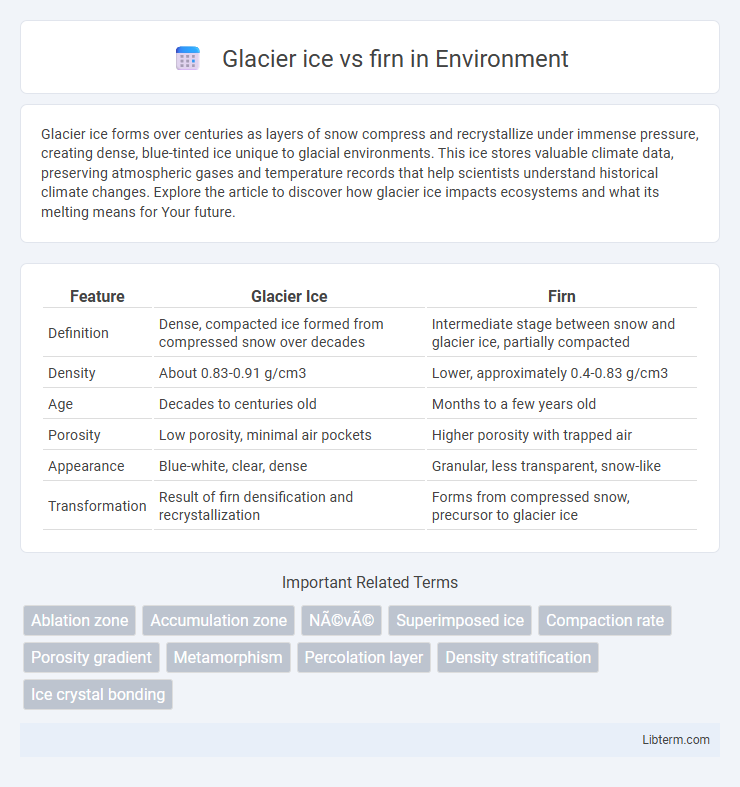Glacier ice forms over centuries as layers of snow compress and recrystallize under immense pressure, creating dense, blue-tinted ice unique to glacial environments. This ice stores valuable climate data, preserving atmospheric gases and temperature records that help scientists understand historical climate changes. Explore the article to discover how glacier ice impacts ecosystems and what its melting means for Your future.
Table of Comparison
| Feature | Glacier Ice | Firn |
|---|---|---|
| Definition | Dense, compacted ice formed from compressed snow over decades | Intermediate stage between snow and glacier ice, partially compacted |
| Density | About 0.83-0.91 g/cm3 | Lower, approximately 0.4-0.83 g/cm3 |
| Age | Decades to centuries old | Months to a few years old |
| Porosity | Low porosity, minimal air pockets | Higher porosity with trapped air |
| Appearance | Blue-white, clear, dense | Granular, less transparent, snow-like |
| Transformation | Result of firn densification and recrystallization | Forms from compressed snow, precursor to glacier ice |
Introduction to Glacier Ice and Firn
Glacier ice forms from the compaction and recrystallization of firn, a granular snow accumulated over multiple seasons. Firn represents an intermediate stage between snow and glacier ice, characterized by increased density but still containing air pockets. The transition from firn to glacier ice occurs as pressure expels air, resulting in a denser, crystalline structure crucial for glacial movement.
Formation Processes of Firn and Glacier Ice
Firn forms through the gradual compaction and recrystallization of snow over multiple seasons, where partially melted and refrozen snowgranules become denser and more compact. Glacier ice develops from firn as continued compression expels air, increasing density while crystal size grows, ultimately creating a solid, dense ice mass with reduced porosity. This transformation involves processes like sintering, meltwater percolation, and pressure-induced recrystallization, which collectively convert loosely bonded firn into coherent glacier ice.
Physical Characteristics: Firn vs Glacier Ice
Firn is granular, compacted snow that has undergone partial melting and refreezing, typically found between snow and glacial ice stages, with air pockets retained within its structure. Glacier ice forms as firn further compresses under pressure, expelling much of the air and developing a denser, more crystalline structure with characteristic blue hues. Physical characteristics distinguishing firn from glacier ice include higher porosity and lower density in firn, whereas glacier ice exhibits increased density, hardness, and reduced permeability.
Differences in Density and Structure
Glacier ice has a higher density, typically around 0.9 g/cm3, compared to firn, which ranges from 0.4 to 0.83 g/cm3 due to its porous nature. Structurally, glacier ice consists of densely packed ice crystals with minimal air pockets, while firn retains some air spaces resembling compacted snow undergoing gradual transformation. These differences in density and structure influence the transition from firn to solid glacier ice during the compaction process in polar and alpine environments.
The Role of Firn in Glacier Evolution
Firn acts as a critical transitional layer between snow and glacier ice, influencing glacier mass balance and structural integrity. Its permeability allows for meltwater percolation and refreezing, which affects glacier density and impacts ice sheet dynamics. Understanding firn processes is essential for modeling glacier evolution and predicting responses to climate change.
Transformation from Firn to Glacier Ice
Firn is compacted snow that has survived one melt season and undergone partial recrystallization, containing air pockets and a granular texture. Over time, continued compaction and recrystallization reduce the porosity of firn, gradually transforming it into dense glacier ice with larger ice crystals and minimal air content. This process, known as densification, occurs under the weight of overlying snow, increasing pressure and temperature slightly to facilitate the transition from firn at depths typically around 50 to 100 meters in glaciers.
Water Content and Permeability Comparison
Glacier ice exhibits significantly lower water content compared to firn, as it consists of dense, compacted ice with minimal pore spaces. Firn retains higher water content due to its granular structure and greater porosity, allowing water to permeate through interconnected voids. The permeability of firn remains relatively high, facilitating water movement, while glacier ice's permeability drastically decreases as crystals fuse, restricting fluid flow.
Importance in Climate and Environmental Studies
Glacier ice and firn are critical indicators in climate and environmental studies as they preserve detailed historical climate records through trapped air bubbles and isotopic compositions. Firn, the intermediate layer between snow and glacier ice, provides insight into recent atmospheric changes, while glacier ice, formed over centuries, offers long-term climate data essential for understanding trends in global warming and ice mass balance. Analyzing both layers enables researchers to reconstruct past temperature fluctuations and predict future climate impacts.
Firn and Glacier Ice in the Hydrological Cycle
Firn represents the intermediate stage between snow and glacier ice within the hydrological cycle, where accumulated snow compacts under pressure, gradually transforming into denser, granular ice over several years. Glacier ice forms when firn undergoes further compaction and recrystallization, creating dense, solid ice that stores significant freshwater reserves and influences long-term water release. Understanding firn and glacier ice dynamics is crucial for predicting meltwater contributions to rivers and managing freshwater resources in glaciated regions.
Summary: Key Distinctions and Implications
Glacier ice forms from tightly compacted firn, exhibiting higher density and fewer air pockets, which directly influences its flow dynamics and optical properties. Firn represents a transitional stage with intermediate density between snow and glacier ice, crucial for understanding glacier mass balance and climate records. The transformation from firn to glacier ice affects glacier dynamics and provides essential data for paleoclimatology through trapped air bubbles.
Glacier ice Infographic

 libterm.com
libterm.com